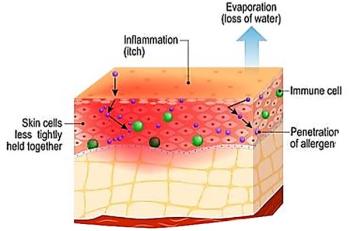
Environmental Triggers of Asthma: NIH Guidelines for Control
Successful long-term management of asthma requires identification and control of environmental factors that increase asthma symptoms and/or precipitate exacerbations. Highlights of guidelines from the Expert Panel of the National Asthma Education and Prevention Program are presented here.
Successful long-term management of asthma requires identification and control of environmental factors that increase asthma symptoms and/or precipitate exacerbations. The Expert Panel of the National Asthma Education and Prevention Program issued guidelines for controlling environmental factors1; highlights of these recommendations are presented here.
The Expert Panel reviewed various environmental factors that contribute to asthma severity and suggested measures to control exposure. Among the factors are inhalant allergens, occupational exposures, and irritants.
INHALANT ALLERGENS
Exposure of vulnerable patients to inhalant allergens increases airway inflammation, airway hyperresponsiveness, symptomatology, need for medication, and incidence of fatal reactions. Thus, all patients with asthma should be queried about exposures to these substances and evaluated for allergen sensitivity.
Diagnosis. Determining a patient’s relevant inhalant sensitivity will enable you to recommend specific environmental controls to reduce exposure. It will also help the patient understand the pathogenesis of asthma and the value of inhalant allergen avoidance. First, determine the patient’s exposure to allergens (Box). Then assess the patient’s sensitivity to these allergens:
?Use the medical history to determine sensitivity to seasonal allergens.
?Use skin testing or in vitro testing to determine the presence of specific IgE antibodies to perennial indoor allergens.
?Assess the clinical significance of positive allergy tests in the context of the patient’s medical history.
Inhalant allergens
Does the patient have symptoms year-round? (If yes, ask the following questions. If no, see the next set of questions.)
?Does the patient have pets and are they kept indoors?
?What types of pets?
?Is there moisture or dampness in any room in the home?
?Is there mold visible in any room in the home?
?Has the patient seen cockroaches or rodents in the home?
?Does the patient use a swamp cooler? (Assume exposure to house dust mites unless the patient lives in a semiarid region, although use of a swamp cooler in such a region makes exposure to house dust mites possible.)
Do the patient’s symptoms worsen at certain times of the year? If so, ask when the symptoms occur. Possible allergens are listed in parentheses.
?Early spring? (Trees)
?Late spring? (Grasses)
?Late summer to autumn? (Weeds)
?Summer and autumn? (Alternaria, Cladosporium, mites)
?Cold months in temperate climates? (Animal dander)
Tobacco smoke
?Does the patient smoke?
?Does anyone smoke at home or work, or in the case of a child, at the child’s day-care facility or school?
Indoor/outdoor pollutants and irritants
?Is a wood-burning stove or fireplace used at home?
?Are there unvented stoves or heaters in the home?
?Is the patient exposed to other odors or fumes from perfumes, cleaning agents, or sprays?
?Have there been recent renovations or painting in the home?
Workplace exposures
?Does the patient cough or wheeze during the week but not on weekends when away from work?
?Do the patient’s eyes and nasal passages get irritated soon after arrival at work?
?Do coworkers have similar symptoms?
?What substances are used in the patient’s workplace?
Management. The most important step in controlling allergen-induced asthma is to reduce exposure to the offending substances. These include indoor allergens-such as animal dander, house dust mites, cockroach allergens, and indoor fungi (molds)-and outdoor allergens, such as pollen (Figure). The Expert Panel emphasized that a multifaceted, comprehensive approach is required for effective allergen avoidance; individual steps alone are rarely sufficient.
Immunotherapy. Consider immunotherapy for asthmatic patients when there is clear evidence of a relationship between symptoms and unavoidable exposure to a relevant allergen; when symptoms occur either all year or during a major portion of the year; and when pharmacologic management of symptoms is difficult. Although several studies of immunotherapy with certain single allergens have demonstrated reduction in asthma symptoms, experts differ in their acceptance of this approach. Adverse reactions to immunotherapy-particularly bronchoconstriction-are more frequent among patients with asthma, especially those with poorly controlled asthma, than among patients who have allergic rhinitis. High-dose sublingual immunotherapy has been reported to be effective in patients with asthma, and this route avoids the risk of systemic reactions. However, studies suggest it is less effective than immunotherapy administered by subcutaneous injection.
Indoor air modification devices. The following measures are recommended:
?Vacuuming carpets once or twice a week to reduce accumulation of house dust. Patients who are sensitive to house dust should avoid using conventional vacuum cleaners and should avoid rooms where a vacuum cleaner is, or has just been, in use. If patients vacuum, they can use a dust mask, a central cleaner with a collection bag located outside the home, or a cleaner with a high-efficiency particulate air (HEPA) filter or a double bag.
?Using central air-conditioning. This prevents entry of outdoor allergens and reduces growth of house dust mites.
?Use of a dehumidifier in areas of year-round high humidity (to reduce dust mite levels).
Humidifiers and evaporative (swamp) coolers are not recommended for use in the homes of patients with asthma who are sensitive to house dust mites.
Indoor air-cleaning devices are not effective substitutes for the measures described in the Table, although some of the devices (eg, electrostatic precipitating filters) can reduce airborne cat dander, mold spores, and particulate tobacco smoke.
OCCUPATIONAL EXPOSURES
Early recognition and control of exposures is critical in occupationally induced asthma, because the likelihood of complete resolution of symptoms decreases with time. Workplace exposure to sensitizing chemicals or dusts can induce asthma, which often persists after the exposure has ended. This condition should be distinguished from allergen- or irritant-induced aggravation of preexisting asthma. Acute exposure to gases, dusts, or fumes can cause reactive airway dysfunction, an asthma-like condition.
Diagnosis. Suspect occupational asthma if the patient reports a correlation between asthma symptoms and work, with improvement after a few days’ absence from the workplace. Since symptoms often begin several hours after exposure, the patient may fail to recognize the correlation. Serial peak flow records at work and way from work can provide confirmation.
In your evaluation, consider the following elements:
Potential for workplace-related symptoms. Determine whether the patient is exposed to recognized sensitizers (eg, isocyanates, plant or animal products) or irritants (eg, cold/heat, dust, humidity), or whether coworkers have similar symptoms.
Symptom patterns. Verify whether there is improvement during vacations or days off (this may take a week or more); whether the symptoms are immediate (less than 1 hour), delayed (generally 2 to 8 hours after exposure), or nocturnal; or whether initial symptoms occur after a high-level exposure (eg, spill).
Documentation of work-related symptoms. Ask the patient to do serial charting for 2 to 3 weeks, recording exposures, symptoms, and bronchodilator use, and measuring and recording peak flow every 2 hours while awake.
Immunologic tests and further confirmatory evaluations. Order as needed.
IRRITANTS
Patients with asthma of any severity should be queried about exposure to irritants (see Box).
Tobacco smoke. This is the most important environmental indoor irritant and is a major precipitant of asthma symptoms in both children and adults. Thus, it cannot be emphasized strongly enough that asthmatic patients should not smoke or be exposed to tobacco smoke.
Outdoor and indoor air pollution and irritants. Asthma symptoms may be precipitated by exposure to increased air pollution levels (especially respirable particulates, ozone, sulfur dioxide, and nitrogen dioxide). Thus, asthmatic patients should avoid exertion or outdoor exercise insofar as possible when levels of air pollution are high.
Patients should also avoid exposure to fumes from unvented gas, oil, or kerosene stoves; wood-burning appliances or fireplaces; and sprays and strong odors, especially perfumes. All of these can irritate the lungs and may precipitate asthma symptoms. In addition, formaldehyde and volatile organic compounds-which can arise from sources such as new linoleum flooring, synthetic carpeting, particleboard, wall coverings, furniture, and recent painting-are potential irritants.
Allergensa
Reduce or eliminate exposure.
?Animal dander. Remove animal from house or, at a minimum, keep animal out of patient’s bedroom.
?House dust mites. Encase mattress in allergen-impermeable cover; encase pillow in allergen-impermeable cover or wash weekly; wash patient’s sheets and blankets weekly in hot water (water temperature of > 130°F is necessary to kill mites, although cooler water and detergent and bleach will reduce number of live mites and allergen level). If possible, reduce indoor humidity to less than 60% (ideal range, 30% to 50%); remove carpets from bedroom; remove carpets laid on concrete; have patient avoid sleeping or lying on upholstered furniture.
?Cockroaches. Use poison bait or traps to control (intensive cleaning is required to reduce reservoirs). Do not leave food or garbage exposed.
?Pollens (from trees, grass, or weeds) and outdoor molds. Adults with allergies should stay indoors with windows closed to the extent possible during problem seasons, especially during the midday and afternoon.
?Indoor mold. Fix all leaks and eliminate water sources associated with mold growth; clean moldy surfaces. If possible, reduce indoor humidity to less than 60% (ideal range, 30% to 50%). Consider a dehumidifier for basements.
Tobacco smoke
Advise patients and others in the home who smoke to either stop smoking or to smoke outside. Reduce exposure to other sources of tobacco smoke.
Indoor/outdoor pollutants and irritants
Reduce exposure to wood-burning stoves or fireplaces; unvented gas stoves or heaters; other irritants (eg, perfumes, cleaning agents, sprays); and volatile organic compounds, such as those that arise from new carpeting and recent painting.
References:
REFERENCE:
1. National Heart, Lung, and Blood Institute.
Newsletter
Enhance your clinical practice with the Patient Care newsletter, offering the latest evidence-based guidelines, diagnostic insights, and treatment strategies for primary care physicians.































































































































































































































































































































